The generational decline is significant, and also fairly consistent over the last decade. (Silents are currently 67-86; Boomers 48-66, Gen Xers 33-47, Millenials 18-31). One reason that Pew points out is that younger generations don't enjoy following the news. For Silents and Boomers, 58% reported that they enjoyed following news "a lot". Less than half of Gen Xers (45%) did so, and less than a third of Millenials (29%).
Looking within generations and across media types, the Silents (67-86) were the most consistent in their patterns of news use, with only minor increases in use of TV and Internet for news, and matching slight declines in use of newspapers and radio. This oldest generation is also the only one where a majority of respondents reported reading a newspaper "yesterday". Yet even with this generation TV (combining broadcast and cable networks) was the most regularly used source for news.
Boomers (ages 48-66), the next generation down, also reported TV as the most frequently used news source, and has been turning to TV more often over time. Their use of the Internet as a source has increased almost 50% over the last decade, and if trends continue, the Internet is likely to become the second most frequently used source for news in the near future. In the latest survey, Internet use "yesterday" was at 35% with a rising trend, while both Newspaper and Radio use was at 36% and trending down.
Gen Xers (33-45) have, over the period of the study, generally preferred electronic media to print. Over the period of this study, less than a third reported reading newspapers "yesterday." In fact, shortly after newspaper use peaked in 2006 (at 32%), it was bypassed by the Internet as a regular source. Online news sources are also on track to become the most widely used news source - with use increasing about 60% in the last 6 years to the point where almost half (49%) of respondents report going online for news "yesterday." Over the same period, use of TV for news has slowly fallen from a peak of 54% to 52% in the latest survey.
For Millennials (18-32), the Internet became the most widely used source for news in the last few years, with 43% reporting that they went online for news "yesterday." TV as a source has fallen from a peak reported use of 49% in 2006 to 36% in 2012, and Newspapers falling from a peak of 22% in 2006 to 14% in 2012. What's interesting for this group is that use of Radio for news has remained fairly consistent, with around a quarter of Millennials reporting using Radio for news "yesterday."
Looking at the generational use patterns can also reinforce the conclusion that there is a generational gap in news consumption. Looking at the highest reported use of a medium for news "yesterday" in 2012 -
- for Millennials, that's the Internet at 43%
- for Gen Xers, that's TV at 52%, but also a greater percentage reported using the Internet (49%)
- for Boomers, that's TV at 65%, with even the least used (Internet) at 35%
- for Silents, that's TV at 73%, and Newspaper (at 51%) more widely used than any Millennial use
For all the potential bad news for the traditional news media, social media looms as a potential booster of news consumption among the younger generation, albeit a modest one so far. Pew Research’s 2012 survey found a third of Millennials and 20 percent of Xers saying they regularly see news or news headlines on social-networking sites. However, only about 35 percent of those who get news from social network sites say they follow up and seek out full news stories.We are living in interesting, and uncertain, times for media and journalism. (So keep following this blog or the JEMS Flipboard magazine.)
Source - Pew surveys of audience habits suggest perilous future for news, Poynter
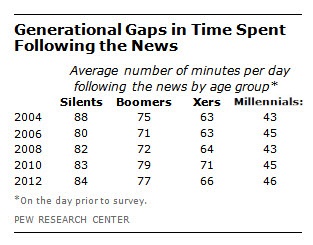
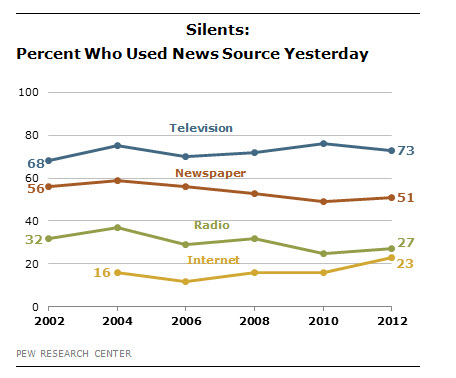
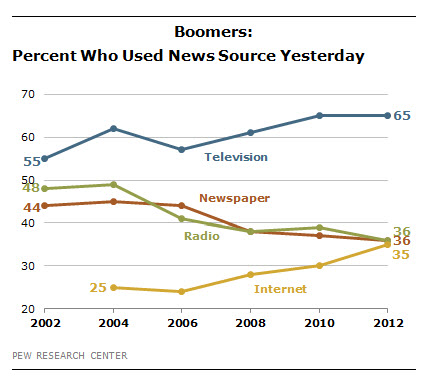
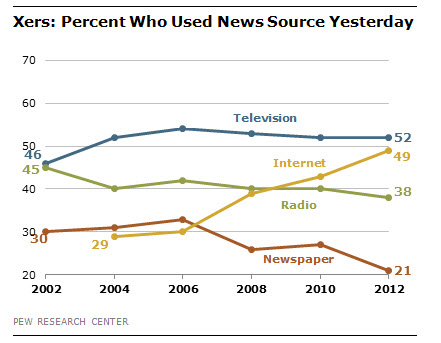
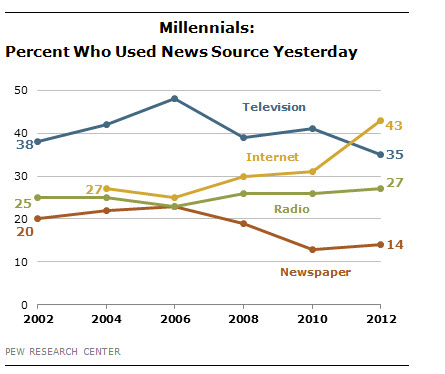
No comments:
Post a Comment